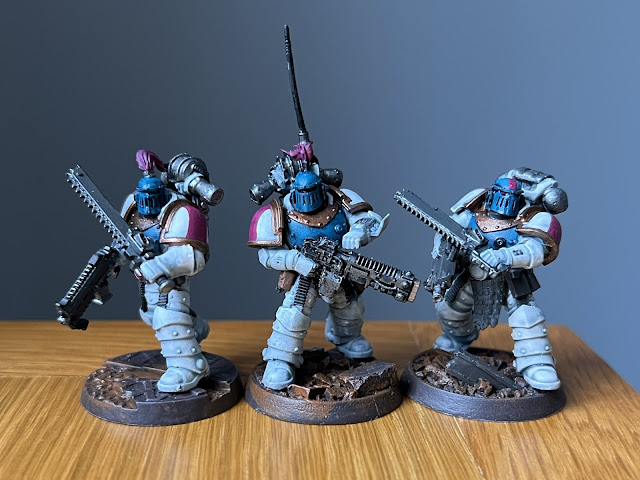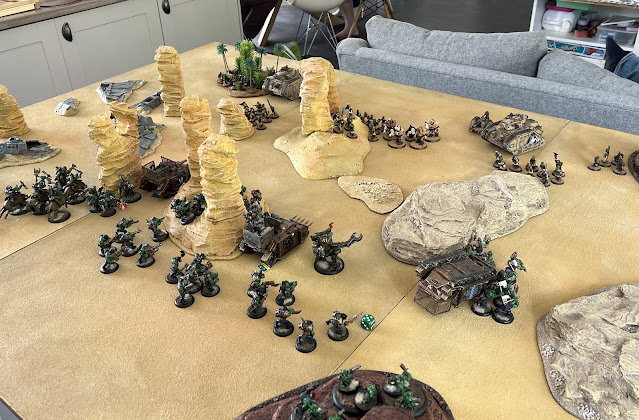+ Combat Strategy +
+ Salamanders reinforcements for The Corsair Gambit III +
+ Another Epic-scale campaign event is coming up – the closing part of Maximal Fire's Corsair Gambit. You can get a ticket here [+noosphericexloadlink embedded+], if you fancy joining in. Having taken the Salamanders to the first two, I wanted to be there in the closing stages, too. +
 |
| + Into the Fires of Battle! + |
+++
+ Plans and preparation +
The
event pack notes that the game size has increased to 3,000pts, so I've got some building and painting to do – though in a pinch I have plenty of Epic Ultramarines and various Titans that can fill in some space, so the pressure is off. Nevertheless, I'd like to have a nice cohesive army, and it'd be good to round off the Salamanders and apply some of the lessons I learned at the previous events.
You can pick up on the previous panic-painting sessions here [
+noosphericinloadlink embedded+], if you're interested in what the rest of the army looks like.
Long-time inloaders will know I like to build campaign-specific stuff for events like this, and since the fighting is taking place on the forgethrone of Legio Maximal, Nabed-Paleae, I'm planning to take a Warlord Titan. The points restrictions for allies (no more than 30%) mean that I'll have to replace Profugon Iratus, the Reaver who spearheaded the previous campaigns, but I do want to make sure that there's at least one Titan from the Legio there, fighting for its homeworld.
+++
+ Salamanders +
While a Warlord Titan will gobble up a significant amount of points (and also help to keep the number of Detachments/Formations down to help with game speed), I've also got some new Space Marines to paint. This is a mix of infantry and armour:
I think Epic-scale games looks best when there's a combined arms approach, with a range of everything from infantry, armour, aircraft and War Engines involved. Happily, GW's new FAQ for Legions Imperialis has addressed quite a few of the bits I disliked about the base ruleset, and has gone some way to rein in the strength and flexibility of infantry.
Nevertheless, what Space Marine army doesn't have lots of Space Marines? I had some Marines left on-sprue from previous events, so it's time for their time in the sun – and guilt-free, as they'll now behave more reasonably than their super-speedy previous incarnation. On the blocks are:
- 8 stands of Tactical Marines
- 2 stands of Plasma Support Marines
- 2 stands of Missile Support Marines
- 2 Command stands.

These won't add up to a huge amount of points, but will allow me to bulk up Detachments and give my marines some real sticking power around objectives. The Salamanders Legion special rule makes them very resilient morale-wise, and this will combine well with the Demi-Company Formation special rule, which makes supporting non-infantry better at supporting them when capturing objectives.
As you can see above, I have created a monstrous 'painting sprue' to hold the marines while I spray and paint them. To do this, simply snip off the extraneous supports, trim those below, and glue it to the remaining sprue so the models stand upright, in a consistent orientation. The two-part missile marines and plasma marines, some of which are oriented differently to the Tacticals, are cut off individually and superglued straight to the bit at the front of the painting sprue.
Once in position, you can prime with brown (I use Colour Forge's Hyrax Brown), then do a zenithal spray of Salamander Green – that is, keep the sprue at a consistent angle, and spray downwards onto the models, so the brown remains visible in the lower recesses.

The same zenithal spraying approach was taken for the vehicles, though since they're considerably larger, I also turned them upside-down and gave them a quick spritz with a darker green to suggest reflected environmental light. The additional armour units are:
- 6 Land Raiders
- 3 Predators
- 2 Kratos
- 5 Land Speeders
- ... and 4 Rhinos, which don't currently have a place in the list, but are on standby to fill in space.
The Kratos are that rare thing in my army – a unit that doesn't have any place in previous editions of the game, and are included slightly begrudgingly as the only Heavy Armour choice currently available to Marines. With that said, I like the models a lot more now I have them in hand, even if they do have the weird half-visible tracks that I find so odd about the newer Marine Armour (Sicarans likewise flashing a bit of thigh).
In terms of armament, I've picked one of each Kratos main gun – primarily to try each one out. These will be Command Tanks, and if time allows, I'd like to go to town on these a little bit with markings and freehand. The Predator squadron is armed with lascannon turrets and heavy bolter sponsons as a bit of a change from the others, which have the old-school autocannon turrets and lascannon sponsons.
+++
+ A minor rant on list-building +
You'll spot that I've got 'spare' Rhinos that may or may not make the list, and that's because I can't bring myself to write a formal list just yet. I find army building in Legions Imperialis a chore. There's loads of fiddly technical hoops to jump through – 'you must have X'; 'you can't have Y'; 'you're only allowed 30%' – but they don't really do much to rein in abuse, as the stories of LI tournaments attests, with armies made of hundreds of Missile Support Marines, Dreadnoughts and Warmaster Titans, with a scant few stands of Tactical Marines to make it legal.
Secondly, the divided nature of the army list across loads of books makes experimenting with lists more awkward; and then there are odd decisions of iconic units like Whirlwinds and Vindicators still not being out, or the Land Raider, the Space Marines' battle tank for forty years inexplicably being made into a Transport...
Oof. All exhausting, and another unnecessary bit of 'mental friction' that prevents people from picking up what is at root a very simple and fun game.
+++
+ Painting +
Once dry, I started painting both infantry and vehicles using the technique outlined in this inload: [
+noosphericinloadlink embedded+]. They're ticking over nicely, but I think I'll have to pick up the pace a bit to get them all up to scratch in time for the event.
Of course, this is where future-proofing comes in handy, because I've got a pile of bases ready and waiting from the last big batch of Epic Salamanders I did – once the marines and Land Speeders are painted, it'll just be a case of gluing them in place.
Speaking of the Land Speeders, the squadron needs a sixth member – en route from the piractical forge-moons of eBay – and because the only ones I can find are pairs, I'll end up with six with the flamer and multimelta option.
It may be objectively worse than the plasma and heavy bolter variant, but who cares when I can indulge the pyromaniacal desires of my mean green Space Marines?
+++
+ What else is new? +
I've got a game of 2nd edition 40k lined up with Bob Hunk – his orks are coming out to give my Steel Legion a kicking – and as you'll see below, there are some 32mm Salamanders awaiting a bit of painterly love.
Oh, and this...





















































